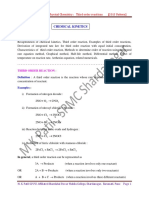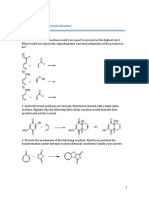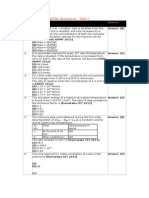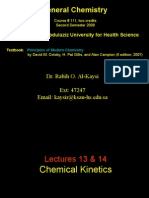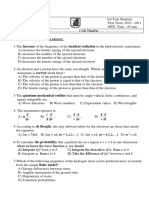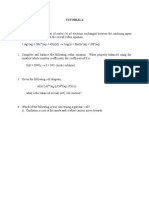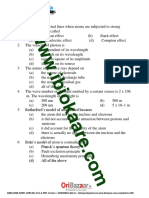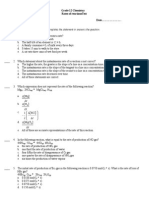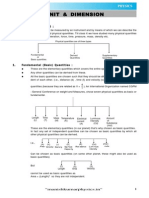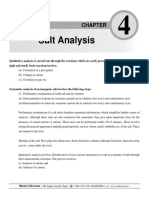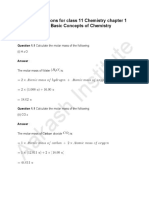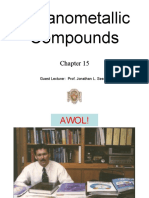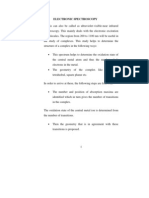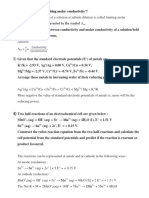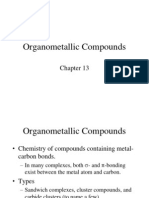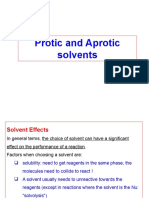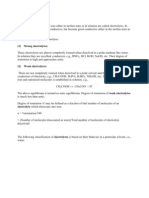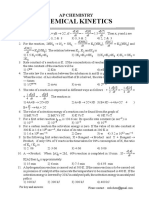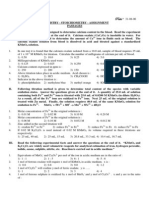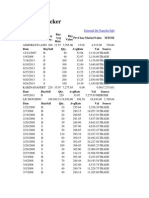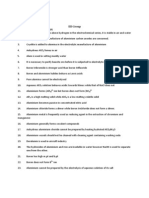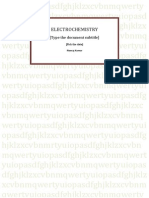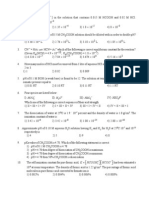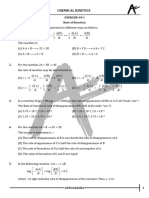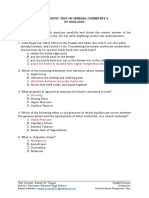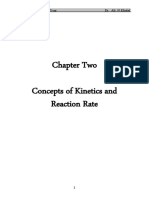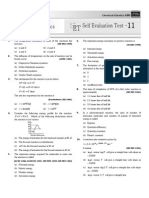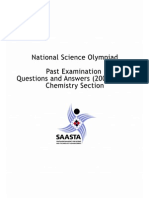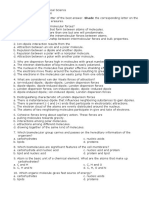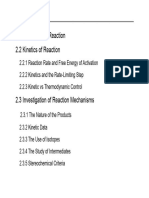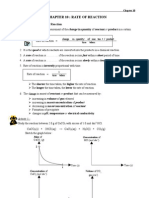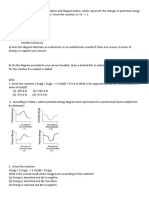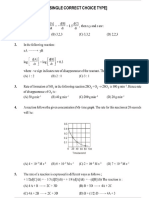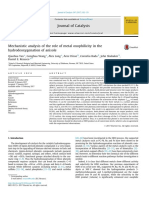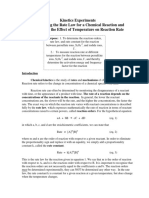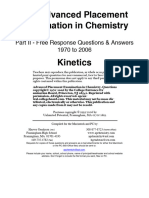Chemical Kinetics-Assignment PDF
Chemical Kinetics-Assignment PDF
Uploaded by
ggk2013Copyright:
Available Formats
Chemical Kinetics-Assignment PDF
Chemical Kinetics-Assignment PDF
Uploaded by
ggk2013Original Description:
Original Title
Copyright
Available Formats
Share this document
Did you find this document useful?
Is this content inappropriate?
Copyright:
Available Formats
Chemical Kinetics-Assignment PDF
Chemical Kinetics-Assignment PDF
Uploaded by
ggk2013Copyright:
Available Formats
Sri Chaitanya IIT- JEE Academy
CHEMISTRY ASSIGNMENT
[Chemical Kinetics]
***************************************************************************************
1. The rate of chemical reaction (except zero order)
1)decreases from moment to moment 2) remains constant throughout
3) depends upon the order of reaction 4) none
2. Radioactive decay follows ______ order kinetics
1) 0 2) I 3) II 4) III
3. The acid hydrolysis of ester is
1) I order reaction 2) bimolecular reaction
3) Pseudo unimolecular reaction 4) none
4. The reaction CH
3
COOC
2
H
5
+NaOH CH
3
COONa+C
2
H
5
OH is
1) bimolecular reaction 2) II order reaction
3) III order reaction 4) none
5. The rate constant of a II order reaction has units
1) mole l
-1
sec
-1
2) litre mole
-1
sec 3) litre mole
-1
sec
-1
4) none of the above
6. For a reaction of II order kinetics its
1
T 2 is
1) o a 2) o a
1
3) o a
2
4) o a
-1
7. The reaction 2Na+Cl
2
= 2NaCl is found to follow III order kinetics. Its molecularity is
1) 1 2) 2 3) 3 4) 4
8. If a is the initial conc. Of a substance which reacts according to zero order kinetic and K is rate constant, the
time for the reaction to go to completion is
1) a K 2) 2 Ka 3) K a 4) 2K a
9. In a reaction, the rate is K[A] [B]
2/3
the O.R. is
1) 1 2) 2 3) 5 3 4) zero
10. Which one does not influence the rate of reaction
1) nature of reactant 2) conc. of reactant
3) temperature 4) molecularity
11. For the reaction A+B products, it is found that the order of A is 2 and of B is 3 in the rate expression
when conc. of both is doubled, the rate will increase by
1) 10 2) 6 3) 32 4) 16
12. For the reaction A B, it is found that the rate of reaction increase by 8 times when the conc. of A is
doubled. The reaction is of .. O.R.
1) 1 2) 2 3) 3 4) 4
13. An increase in rate of reaction for a rise in temperature is due to
1) increase in collision frequency 2) shortening of mean free path
3) increase in the number of activated molecules 4) none
14. The rate at which a substance reacts is proportional to its
1) equivalent weights 2) molecular weights
3) number of moles 4) number of moles per litre
15. The rate constant of a reaction has same units as the rate of reaction. The rate is of
1) zero order 2) first order 3) second order 4) none of these
16. Increase in the concentration of the reactants leads to the change in
1) heat of reaction 2) activation energy
3) collision frequency 4) none of these
17. For a molecular collision to be effective, it should satisfy the following condition
1) it should involve the molecules having a certain minimum amount of energy
2) it should involve only ionic compounds
3) it should involve molecules having a certain minimum amount of energy and a proper orientation
4) it should involve two or three molecules
18. An endothermic reaction A B has an activation energy as x kJ mole of A. If energy change of the
reaction is y kJ, the activation energy of the reverse reactions is
1) x 2) x y 3) x+y 4) y x
19. The reactions of high molecularity are rare because
1) many body collisions have a low probability
2) many body collisions are not favoured energetical
3) activation energy of many body collision is very high
4) activation energy of many body collision is very low
20. The activation energy of exothermic reaction A B is 20 k.cal. The heat of reaction is 50 k.cal. The
activation energy for the reaction B A will be
1) 20 k.cals 2) 30 k.cals 3) 70 k.cals 4) 50 k.cals
21. Increase in concentration of the reactants results in
1) decrease in rate of the reaction 2) increase in rate of the reaction
3) both increase or decrease in rate depending upon the nature of the reactants
4) none of the above
22. For a chemical reaction 2x+y z the rate of appearance of z is 0.05 mol L
-1
per min. The rate of
disappearance of x will be
1) 0.05 mol L
-1
per hour 2) 0.05 mol L
-1
per min
3) 0.1 mol L
-1
min
-1
4) 0.25 mol L
-1
per min
23. The activation energy of a reaction is zero. The rate constant of the reaction
1) increases with increase of temperature 2) decreases with increase of temperature
3) decreases with decrease of temperature 4) is nearly independent of temperature
24. Order of reaction is
1) always equal to its molecularity 2) always a fraction
3) always an integral number 4) the sum of the exponents in rate law
25. The specific rate of a first order reaction depends on
1) the concentration of the reactants 2) the concentration of the products
3) temperature 4) time
26. The correct expression for Arrhenius equation showing the effect of temperature on the rate constant is
1)
a 2 2 1
1 1 2
E K T - T
K 2.303R T T
= 2)
a 2
1 1 2
E K 1 1
ln -
K R T T
| |
=
|
\ .
3)
Ea RT
K = Ae 4)
a 2 1 2
1 2 1
E K T T
log =
K 2.303 T - T
27. For the first order reaction half-life is 14s. The time required for the initial concentration to reduce to
th
1 8
of its value is
1) 28 s 2) 42 s 3) (14)
3
s 4) (14)
2
s
28. The rate law for the reaction
RCI+NaOH(aq) ROH+NaCl is given by, Rate = K[RCl] the rate of the reaction will be
1) doubled on doubling the concentration of sodium hydroxide
2) halved on reducing the concentration of alkyl halide to one half
3) decreased on increasing the temperature of the reaction
4) unaffected by increasing the temperature of the reaction
29. The rate constant of a reaction depends on
1) temperature 2) mass 3) weight 4) time
30. For a given rate law 2A+B C+D, the active mass of B is kept constant but that of A is tripled. The rate
of reaction will
1) decrease by 3 times 2) increase by 9 times
3) increase by 3 times 4) unpredictable
31. Taking the reaction A+2B products to be of second order which of the following is the rate law
expression for the reaction?
1)
dx
= K[A][B]
dt
2)
2
dx
= K[A][B]
dt
3)
2
dx
= K[A] [B]
dt
4)
2
dx
= K[A]+[B]
dt
32. Consider a gaseous reaction, the rate of which is given by K[X][Y]. The volume of the reaction vessel
containing these gases is suddenly reduced to 1/4
th
of the initial volume. The rate of the reaction as
compared with original rate is
1) 1/16 times 2) 16 times 3) 1/8 times 4) 8 times
33. The rate of a reaction that does not involve gases, does not depend upon
1) pressure 2) temperature 3) concentration 4) datalyst
34. For a reaction, a plot of log (a x) versus time (t) is a straight line with slope equal to K 2.303, the reaction
is of
1) zero order 2) first order 3) second order 4) third order
35. The rate constant of a reaction is 5.210
-1
minutes
-1
the order of the reaction is
1) one 2) zero 3) two 4) three
36. The first order rate constant for decomposition of N
2
O
5
is 6.9310
- 4
sec
-1
. What is half change time for
decomposition?
1) 10
2
sec 2) 10
3
sec 3) 10
4
sec 4) 10 sec
37. The half-life period of a first order reaction is 15 minutes. The amount of substance left after one hour will be
1) one half 2) one fourth 3) one eight 4) one sixteenth
38. For a reaction A+2B C+D, the following data, were obtained
Expt. initial conc. initial conc. initial rate of
(mol. L
-1
) (mol L
-1
) formation of D
[A] [B] (mol L
-1
min
-1
)
1) 0.1 0.1 6.010
-3
2) 0.3 0.2 7.210
-2
3) 0.3 0.4 2.8810
-1
4) 0.4 0.1 2.410
-2
The correct rate law expression will be
1) Rate = K[A][B] 2) Rate = K[A][B]
2
3) Rate = K[A]
2
[B]
2
4) Rate = P[A]
2
[B]
39. The rate of the reaction A+B+C products is given by
1 2 1 3 1 4
- d[A]
r = = K[A] [B] [C]
dt
the order of
reaction is
1) 1 2) 2 3) 1 2 4) 13 12
40. In a reaction the rate was found to be independent of the concentration of the reactants. The reaction is of
1) 1
st
order 2) 2
nd
order 3) order 1.5 4) zero
41. Which one of the following factors does not influence the reactions rates?
1) concentrations 2) temperature 3) size of the vessel 4) catalyst
42. In a multistep reaction, the overall rate of reaction is
1) equal to the rate of slowest step 2) equal to the rate of fastest step
3) equal to the average rate of various steps 4) equal to the rate of the last step
43. Which of the following expression is correct for second order reactions (C
0
refers to initial concentration of
reactant)
1)
1 2 0
t C 2)
-1
1 2
t C 3)
-2
1 2 0
t C 4)
0
1 2 O
t C
44. The effect of temperature on reaction rate is given by
1) Clausius claperon equation 2) Arrhenius equation
3) Gibbs Helmholtz equation 4) General gas equation
45. For a reaction pA+qB products, the rate law expression is r = K[A]
l
[B]
m
then
1) (p+q) = (l+m) 2) (p+q) = (l+m)
3) (p+q) may or not be equal to (l+m) 4) (p+q) > (l+m)
46. The rate of reaction 2NO+Cl
2
2NOCl becomes doubled when the concentration of Cl
2
is doubled
however, when the concentration of both the reactants are doubled the rate becomes eight times. What is
order of the reaction
1) first 2) second 3) third 4) zero
47. The rate constant of a reaction is 1.210
-2
mol
-2
lit
2
sec
-1
. The order of reaction is
1) zero 2) 1 3) 2 4) 3
48. For the reaction A+2B+C D+2E the rate of formation of D is found to be
(a) doubled when [A] is doubled keeping [B] and [C] constant
(b) doubled when [C] is doubled keeping [A] and [B] constant
(c) the same when [B] is doubled keeping [A] and [C] constant.
Which one is the rate equation for the reaction?
1) rate = K[A][B][C] 2) rate = K[A]
0
[B][C] 3) rate = K[A][B]
0
[C] 4) rate = K[A][B][C]
0
49. The concentration of a reactant in a solution falls (i) from 0.2 to 0.1M in 2 hrs (ii) from 0.2 to 0.05M in 4 hr.
The order of the hydrolysis of the reactant is
1) zero 2) two 3) one 4) half
50. Two gases A and B are filled in a container, the experimental rate law for the reaction between them, has
been found to be Rate = K[A][B] predict the effect on the rate of the reaction when pressure is doubled
1) the rate is doubled 2) the rate becomes four times
3) the rate becomes eight times 4) none of the above
51. The rate of the first order reaction X products is 7.510
-4
mol lit
-1
s
-1
. When the concentration of x is
0.5 mole L
-1
. The rate constant in seconds is
1) 3.7510
-4
S
-1
2) 2.510
-4
S
1
3) 1.510
-3
S
1
4) 3.010
-4
S
-1
52. For the reaction 2A+B D,
2
- d[A]
=K[A] [B]
dt
. The expression for
- d[B]
dt
will be
1) K[A]
2
[B] 2) 2K[A]
2
[B] 3) K[2A]
2
[B] 4)
2
1
K[A] [B]
2
53. A hypothetical reaction A
2
+B
2
2AB follows the mechanism as given below.
2
A A+A (fast)
2
A+B AB+B (slow) A+B AB (fast)
The order of the over all reaction is
1) 2 2) 1 3)
1
1
2
4) 0
54. For a chemical reaction 2X+Y Z the rate of appearance of Z is 0.05 mol L
-1
per min. The rate of
disappearance of x will be
1) 0.05 mol L
-1
per hour 2) 0.05 mol L
-1
per min.
3) 0.1 mol L
-1
min
-1
4) 0.25 mol L
-1
per min.
55. An endothermic reaction A B has an activation energy of 10 K.cals/mole and heat of the reaction is 5
k.cals/mole. The activation energy of the reaction B A is
1) 20 k.cal/mole2) 5 k.cal/mole 3) 10 k.cal/mole4) zero
56. The decomposition of a substance R takes place according to first order kinetics. Its initial concentration is
reduced to 1/8
th
in 24s. The rate constant of the reaction is
1)
-1
1 24 S 2)
-1
0.69 16 S 3)
-1
ln 2 8 S 4)
-1
1 8 S
57. The half life period of a first order reaction
2.303 a
K = log
t a - x
is
1) directly proportional to a 2) inversely proportional to a
3) independent of a 4) proportional to (a x)
58. The incorrect order indicated against the rate of reaction A+B C is
Rate Order Rate Order
1)
d[C]
= K[A]
dt
1 2)
d[C]
= K[A][B]
dt
2
3)
0
d[A]
= K[A][B]
dt
2 4)
d[A]
= K[A]
dt
1
59. The minimum energy necessary to permit a reaction to occur is
1) internal energy 2) threshold energy
3) activation energy 4) free energy
60. For a zero order reaction
1)
1 2 0
t C 2)
1 2 0
T 1 C 3)
2
1 2 0
t C 4)
2
1 2 0
t 1 C
61. A first order reaction has specific rate constant of 2 min
-1
. The half-life of this reaction will be
1) 1.653 min 2) 0.347 min 3) 2 min 4) 0.5 min
62. For a first order reaction we have k=100 sec
-1
. The time for completion of 50% reaction is
1) 1m sec 2) 4m sec 3) 7m sec 4) 10m sec
63. For the reaction A+2B C, the rate of reaction at a given instant can be represented by
1)
d[A] 1 d[B] d[C]
+
dt 2 dt dt
= + = + 2)
d[A] 1 d[B] d[C]
dt 2 dt dt
= + =
3)
d[A] 1 d[B] d[C]
dt 2 dt dt
= = + 4)
d[A] 1 d[B] d[C]
dt 2 dt dt
+ = + = +
64. In photochemical reactions
1) temperature has the same effect as on thermal reactions
2) temperature has opposite effect as on thermal reactions
3) temperature has no effect
4) temperature may have a little effect in certain cases
65. In the reaction A+B AB if the concentration of A is doubled, the rate of reaction will
1) be doubled 2) be decreased to one half
3) increase four times 4) remain unaffected
66. The amount of
( )
128
53 1 2
D t - 25 minutes left after 50 minutes will be
1) 1 4 2) 1 2 3) 1 3 4) none of these
67. The first order rate constant for the decomposition of N
2
O
5
is 610
-4
second
-1
. The half life period for the
decomposition in second is
1) 1155 2) 115.5 3) 11.55 4) 1.155
68. If the half-time for a particular reaction is found to be constant and independent of the initial concentration
of the reactions then reaction is
1) first order 2) zero order 3) second order 4) none of these
69. If initial concentration of reactants in certain reaction is doubled, the half life period of the reaction doubles,
the order of a reaction is
1) zero 2) first 3) second 4) third
70. The rate of reaction A+B products is given by the equation r=K[A][B]. If B is taken in large excess, the
order of the reaction would be
1) 2 2) 1 3) 0 4) unpredictable
71. In the reaction, A+2B C+2D, the initial rate
- d[A]
dt
at t = 0 was found to be 2.610
-2
m sec
-1
. What is
the value of
- d[B]
dt
at t = 0 in m sec
-1
?
1) 2.610
-2
2) 5.210
-2
3) 1.010
-1
4) 6.510
-3
72. The unit of the velocity constant in case of zero order reaction is
1) conc time
-1
2) conc
-1
time 3) conc
-1
time
-1
4) conc (time)
2
73. The conversion of molecules A to B follows second order kinetics. Doubling the concentration of A will
increase the rate of formation of B by
1) a factor 2 2) a factor of 4 3) factor of 1 2 4) a factor of 1 4
74. Of the concentration of a reactant A is doubled and the rate of its reaction increases by a factor of 2, the
order of reaction with respect to A is
1) first 2) zero 3) second 4) third
75. If initial concentration is tripled, the time for half reaction is also tripled, the order of reaction is
1) zero 2) first 3) second 4) third
76. Rate of chemical reaction can be kept constant
1) by starting the components 2) by keeping the temperature
3) both of above 4) none of above
77. Which of the following into laws has an overall order of 0.5 for reaction involving substances x and y?
1) ( )( )
x y
Rate = K C C 2) ( ) ( )
0.5
0.5
x y
Rate = K C C
3) ( ) ( )
1
1.5
x y
Rate = K C C
4) ( )( )
1.5
x y
Rate = K C C
78. The hydrolysis of methyl formate in acid solution has rate expression
| |
+
3
rate = K HCOOCH H (
the
balanced equation being HCOOCH
3
+H
2
O HCOOH+CH
3
OH. The rate law contains
+
H (
though the
balanced equation does not contain
+
H (
because
1) more for convenience to express the rate law
2) H
+
ion is a catalyst
3) H
+
is an important constituent of any reaction
4) All acids contain H
+
ions
79. In a catalytic conversion of N
2
to NH
3
by Habers process the rate of change in the concentration of NH
3
per
time is 4010
-3
mol l
-1
. If there is no side reaction the rate of the change as expressed in terms of hydrogen is
1)
-3 -1 -1
60 10 mol l s 2)
-1 -1
1200 mol l s
3)
-3 -1 -1
2010 mol l s 4)
-3 -1 -1
10.310 mol l s
80. In which of the following cases does the reaction go to farthest to completion?
1) k = 10 2) k = 1 3) k = 10
3
4) k = 10
-2
81. For an exothermic reaction the energy of activation of the reactant is
1) equal to the energy of activation of products
2) less than the energy of activation of products
3) greater than the energy of activation of products
4) sometimes greater and sometimes less than that of the products
82. In a reaction x+y products, it was found that (i) on doubling the concentration of x, the rate doubled (ii)
on doubling the concentration on y, the rate of the reaction increased four times, the over all order of the
reactant is
1) 3 2) 2 3) 1 4) 0
83. The hydrolysis of ester in alkaline medium is a
1) 1
st
order reaction with molecularity 1 2) 2
nd
order reaction with molecularity 2
3) 1
st
order reaction with molecularity 2 4) 2
nd
order reaction with molecularity 1
84. For the chemical change A B, it is found that the rate of reaction doubles when the concentration is
increased four times. The order A for this reaction is
1) two 2) zero 3) one 4) half
85. For reaction 4A+B 2C+2D which of the following statements is not correct?
1) the rate of disappearance of B is one fourth of the rate of disappearance of A
2) the rate of appearance of C is one half the rate of disappearance of B
3) the rate of formation of D is one half the rate of consumption of A
4) the rates of formation of C and D are equal
86. The units for the rate constant to first order reaction is
1) S
-1
2) mol L
-1
S
-1
3) mol S
-1
4) L mol
-1
S
-1
87. The rate of a certain reaction at different times are as follows
Time (min) 0 10 20 30
Rate 2.810
-2
2.810
-2
2.8110
-2
2.7910
-2
(moles litre
-1
min
-1
)
the order of the reaction is
1) one 2) two 3) three 4) zero
88. The reaction, 2A+2B products, the following initial rates were obtained at various initial concentrations
[A] [B] Rate (mol l
-1
sec
-1
)
0.1 M 0.2 M 0.46
0.2 M 0.2 M 1.84
0.2 M 0.1 M 0.92
The rate law for the reaction is
1) Rate = K[A]
2
[B]
0
2) Rate = K[A][B] 3) Rate = K[A]
2
[B] 4) Rate = K[A][B]
2
89. The reaction 2H
2
O
2
2H
2
O+O
2
is, | |
2 2
r = K H O
1) zero order reaction 2) first order reaction
3) second order reaction 4) third order reaction
90. A substance A decomposes in solution following the first order kinetics. Flask I contains 1 L of 1 M solution of
A and flask II contains 100ml of 0.6 M solution. After 8 hr. the concentration of A in flask I becomes 0.25M,
what will be time for concentration of A in flask II to become 0.3M
1) 0.4 hr. 2) 2.4 hr. 3) 4.0 hr.
4) un predictable as rate constant is not given
91. The unit of rate constant for a zero order reaction is
1) litre sec
-1
2) litre mole
-1
sec
-1
3) mole litre
-1
sec
-1
4) mole sec
-1
92. The rate constant for a first-order reaction whose half-life is 480 sec. is
1) 1.4410
-3
sec
-1
2) 1.44 sec
-1
3) 0.7210
-3
sec
-1
4) 2.8810
-3
sec
-1
93. The rate of a chemical reaction doubles for every 10
0
C rise in temperature. If the rate is increased by 60
0
C,
the rate of reaction increases by about
1) 20 times 2) 32 times 3) 64 times 4) 128 times
94. Which of the following statement about the order of reaction is true?
1) the order of a reaction increases with increase in temperature
2) the order of a reaction can be determined from the balanced equation
3) a second-order reaction is also bimolecular
4) the order of a reaction can only be determined
95. The rate of the reaction
2 2 3
N (g)+3H (g) 2NH (g) was measured as
| |
4 -1 -1
3
1 d
NH 2 10 mol L sec
2 dt
+ = . The rates of the reaction expressed in terms of N
2
and H
2
are rate in
terms of N
2
rate in terms of H
2
.
( )
-1 -1
mol L sec
( )
-1 -1
mol L sec
( )
-1 -1
mol L sec
( )
-1 -1
mol L sec
1) 110
-4
110
-4
2) 310
-4
110
-4
3) 110
-4
110
-4
4) 210
-4
610
-4
96. The unit for specific reaction rate of second order reaction is
1) sec
-1
2) mole litre
-1
sec
-1
3) litre
2
mole
-2
sec
-1
4) litre mole
-1
sec
-1
97. The rate of a gaseous reaction is equal to K[A][B]. The volume of the reaction vessel containing these gases
is suddenly reduced to one-fourth the initial volume. The rate of the reaction would be
1) 1 16 2) 16 1 3) 1 8 4) 8 1
98. Diazonium salt decomposes as
+ -
6 5 2 6 5 2
C H N Cl C H Cl+N . At 0
0
C, the evolution of N
2
becomes two
times faster when the initial concentration of the salt is doubled. Therefore it is
1) a first order reaction 2) a second order reaction
3) independent of the initial concentration of the salt 4) a zero order reaction
99. Which one of the following rate laws has an overall order of 0.5 for the reaction involving substances X, Y, Z?
1) ( )( )( )
x y z
Rate = K C C C 2) ( ) ( ) ( )
0.5
0.5 0.5
x y z
Rate = K C C C
3) ( ) ( ) ( )
1
1.5 0
x y z
Rate = K C C C
4) ( )( )
0
x z
Rate = K C C
( )
2
y
C
100. The conversion of A B follows second order kinetics. Doubling the concentration of A will increase the
rate of reaction by a factor of
1) 2 2) 1 2 3) 4 4) 1 4
101. In the reversible reaction
1
2
K
2 2 4
K
2NO N O
the rate of disappearance of NO
2
is equal to
1) | |
2
1
2
2
2K
NO
K
2) | | | |
2
1 2 2 2 4
2K NO - 2K N O
3) | |
2
1 2
2K NO 4) ( ) | |
1 2 2
2K - K NO
102. The given reaction 2FeCl
3
+SnCl
2
2FeCl
2
+SnCl
4
is an example of
1) first order reaction 2) second order reaction 3) third order reaction 4) none of these
103. For the reaction A+B C, it is found that doubling the concentration of A increase the rate 4 times and
doubling the concentration of B doubles the reaction rate. What is the overall order of the reaction
1) 3 2 2) 4 3) 1 4) 3
104. A first order is half completed in 45 minutes. How long does it need for 99.9% of the reaction to be
completed?
1) 20 hours 2) 10 hours 3)
1
7
2
hours 4) 5 hours
105. In a reaction: A B, the rate of reaction increases two times on increasing the concentration of the
reactants four times, then the order of the reaction is
1) 0 2) 2 3) 1 2 4) 4
106. Milk turns sour at 40
0
C three times as faster at as 0
0
C. Hence E
o
(activation energy) of turning of milk sour is
1)
2.303 2 313 273
log 3 cal
40
2)
2.303 2 313 273
log (1/3) cal
40
3)
2.303 2 40
log 3 cal
273 313
4)
2.303 2 40
log (1/3) cal
273 313
107. A graph between log( )
50
T , and log (conc.) for n
th
order reaction is a straight line.
Reaction of this nature is completed 50% in 10 minutes when conc. is 2 mol L
-1
. This
is decomposed 50% in t minutes at 4 mol L
-1
n and t are
1) 0.20 min 2) 1, 10 min 3) 1, 20 min 4) 0, 5 min
108. Graph between log k and
1
T
(k is rate constant (s
-1
) and T the temperature (K)) is
a straight line with OX=5,
-1
1
= Tan
2.303
| |
|
\ .
. Hence E
a
will be
1) 2.3032 cal 2)
2
cal
2.303
3) 2 cal 4) none
109. Half life ( )
1
T of the first order reaction and half life ( )
2
T of the second order reaction are equal. Hence
ratio of the rate at the start of the reaction
2
1
T =
rate constant initial constant
| |
|
\ .
1) 1 2) 2 3) 0.693 4) 1.44
110. Rate constant k of a reaction is 0.0693 min
-1
. Starting with 20 mol L
-1
, rate of the reaction after 10 min. will
be
1) 0.693 mol L
-1
min
-1
2) 1.386 mol L
-1
min
-1
3) 0.0693 mol L
-1
min
-1
4) 6.93 mol L
-1
min
-1
111. The rate of a chemical reaction generally increases rapidly even for small temperature increase because of a
rapid increase in the
1) collision frequency
2) fraction of molecules with energies in excess of the activation energy
3) activation energy
4) average kinetic energy of molecules
112. For a reaction rate constant is equal to rate of the reaction of all concentrations, the order is
1) 0 2) 2 3) 3 4) 1
113. Rate constant of a reaction k is 3.010
-4
s
-1
, energy of activation E
a
= 104.4 kJ mol
-1
and Arrhenius constant A
is 6.010
14
s
-1
at 298 K. The value of rate constant k as a T is
1) 2.010
18
s
-1
2) 6.010
14
s
-1
3) infinite 4) 3.610
30
s
-1
114. A tangent drawn on the curve obtained by plotting concentration of product (mole L
-1
) of a first order
reaction vs. time (min) at the point corresponding to time 20 minute makes an angle to 30
0
with
concentration axis. Hence the rate of formations of product after 20 minutes will be
1) 0.580 mole L
-1
min
-1
2) 1.723 mole L
-1
min
-1
3) 0.290 mole L
-1
min
-1
4) 0.866 mole L
-1
min
-1
115. For reaction 3A products, it is found that the rate of reaction increases 4-fold when concentration of A
is increased 16 times keeping the temperature constant. The order of reaction is?
1) 2 2) 1 3) 3 4) 0.5
116. The reaction; 2O
3
3O
2
, is assigned the following mechanism
I. O
3
O
2
+O
II. O
3
+O
2
slow
2O
The rate law of if the reaction will therefore be
1) | | | |
2
3 2
r O O 2) | | | |
2 1
3 2
r O O
3) | |
3
r O 4) | | | |
2
3 2
r O O
117. Decomposition of N
2
O
5
occurs in the following manner 2N
2
O
5
4NO
2
+O
2
its rate is expressed in three
ways
(i)
| |
( )
2 5 11
2 5
d N O
k N O
dt
= (ii)
( )
( )
2 1
2 5
d NO
k N O
dt
= (iii)
( )
( )
2 11
2 5
d O
k N O
dt
=
What is the relation between k &
'
k
1) k =
'
k 2) k = 2
'
k 3)
'
k = 2k 4)
'
k = 1 3 k
118. All chemical reactions take place at a definite rate depending on the conditions, of which the important are
1) concentration of reactants 2) temperature
3) radiation 4) presence of a catalyst
119. The rate constant of a reaction depends on
1) temperature 2) mass 3) density 4) time
120. The rate at which a substance reacts depends on its
1) atomic mass 2) equivalent mass 3) molecular mass 4) active mass
121. The rate expression for a reaction is
3 2 -1
rate = k[A] [B] , the order of reaction is
1) 0 2) 1 2 3) 3 2 4) 5 2
122. Which of the following rate law has an overall order of 0.5 for the reactions involving substances x, y, z?
1) ( )( )( )
x y z
Rate = k C C C 2) ( ) ( ) ( )
0.5
0.5 0.5
x y z
Rate = k C C C
3) ( ) ( ) ( )
1
1.5 0
x y z
Rate = k C C C
4)
( )( )
( )
0
x z
2
y
R C C
Rate =
C
123. The reaction A(g)+2B(g) C(g)+D(g) is an elementary process. In an experiment the initial partial
pressure of A & B are P
A
= 0.60 and P
B
= 0.80 atm. When P
C
= 0.2 atm the rate of reaction relative to the
initial rate is
1) 1 48 2) 1 24 3) 9 16 4) 1 6
124. If concentration are measured in mole/lit and time in minutes, the unit for the rate constant of a 3
rd
order
reaction are
1) mol lit
-1
min
-1
2) lit
2
mol
-2
min
-1
3) lit. mol
-1
min
-1
4) min
-1
125. A radioactive element has a half life period of 140 days. How much of it will remain after 1120 days
1)
1
32
2)
1
256
3)
1
512
4)
1
128
126. For a first order reaction the plot of log
t
[A] Vs t is linear with a
1) positive slope and zero intercept 2) positive slope and non zero intercept
3) negative slope and zero intercept 4) negative slope and non zero intercept
127. The rate law for the reaction
RCl+NaOH(aq) ROH+NaCl
is given by Rate = k[RCl]. The rate of the reaction will be
1) unaffected by increasing temperature of the reaction
2) doubled on doubling the concentration of NaOH
3) halved on reducing the concentration of NaOH to one half
4) halved on reducing the concentration of RCl to one half
128. For a given reaction of first order, it takes 20 minutes for the concentration to drop from 1.0 mol litre
-1
to 0.6
mol litre
-1
. The time required for the concentration to drop from 0.6 mol litre
-1
to 0.36 mol litre
-1
will be
1) more than 20 minutes 2) less than 20 minutes
3) equal to 20 minutes 4) infinity
129. The unit of rate constant of a reaction having order 1.5 would be
1)
( )
1/ 2
-1 -1
mol L s
2)
( )
3/ 2
-1 -1
mol L s
3) (conc)
- 0.5
time
-1
4) (conc)
- 0.75
time
-1
130. A catalyst lowers the activation energy of the forward reaction by 20 kJ mol
-1
. It also changes the activation
energy of the backward reaction by an amount
1) equal to that of forward reaction
2) equal to twice that of the forward reaction
3) which is determined only by the average energy of products
4) which is determined by the average energy of products relative to that of reactants
131. The half-life period of a radioactive element is 140 days. After 560 days, one gram of the element will reduce
to
1) ( ) 1 2 g 2) ( ) 1 4 g 3) ( ) 1 8 g 4) ( ) 1 16 g
132. For a second order reaction of the type rate = k[A]
2
, the plot of 1/ [A]
t
versus t is linear with a
1) positive slope and zero intercept 2) positive slope and non zero intercept
3) negative slope and zero intercept 4) negative slope and non zero intercept
133. The following statement(s) is (are) correct
1) A plot of log K versus 1/T is linear
2) A plot of log (x) versus time is linear for a first order reaction XP
3) A plot of log P versus 1/T is linear at constant volume
4) A plot of P versus 1/V is linear at constant temperature
134. The decomposition of Cl
2
O
7
at 400k in the gas phase to Cl
2
and O
2
is a first order reaction
(i) After 55 seconds at 400K the pressure of Cl
2
O
7
falls from 0.062 to 0.044 atm. The rate constant and
pressure of Cl
2
O
7
after 100 sec of decomposition at this temperature are
1) 5.210
-4
sec
-1
; 0.05 atm 2) 6.210
-3
sec
-1
; 0.033 atm
3) 5.810
-3
sec
-1
; 0.44 atm 4) 4.610
-3
sec
-1
; 0.005 atm
135. Suppose one does not have an experimental procedure to follow the kinetics of a first order reaction with a
half life less than 0.3 nano seconds, then
1) The minimum value of rate constant that can still be measured is 2.3110
12
sec
-1
2) The maximum value of rate constant that can still be measured is 8.31610
12
hr
-1
3) The minimum value of rate constant that can still be measured is more than 8.31610
12
hr
-1
4) The maximum value of rate constant, that can still be measured is less than 510
-1
hr
-1
.
136. 75% of a 1
st
order reaction was completed in 32 minutes. When was 50% of the reaction completed
1) 24 min 2) 4 min 3) 16 min 4) 8 min
5) none of these
137. For a general reaction,
aA+bB cC+dD
the rate of reaction may be give as
1)
b A
A B
dC 1
r = - k C C
dt a
= 2)
a b B
A B
dC 1
r = - k C C
dt b
=
3)
a b C
A B
dC 1
r = k C C
dt c
= 4)
a b D
A B
dC 1
r = - k C C
dt d
=
138. The half life of a second order reaction is
1)
1/2
t = 0.693/k 2)
1/2 0
t = k[A] 3)
1/2 0
t = [A] / k 4)
1/2
0
1
t =
k[A]
139. According to Arrhenius the relationship between rate constant, k and temperature can be given by
1)
- Ea RT
k = Ae 2)
a 2 2 1
1 1 2
E k T - T
log =
k 2.303R TT
3)
a
E
log k = logA -
2.303RT
4) AG
0
= - 2.303 RT log K
140. What will be the amount of ( )
n
m 1/2
X t 25 min = left after 50 minutes?
1) 1/2 2) 1/4 3) 1/3 4) 1/10
141. What is the activation energy for the decomposition of N
2
O
5
as
2 5 2 2
1
N O 2NO O
2
+
If the values of the rate constants are 3.4510
-5
and 6.910
-3
at 27
0
C and 67
0
C respectively
1) 10210
2
kJ 2) 488.5 kJ 3) 112 kJ 4) 112.5 kJ
142. 50% of the amount of a radioactive substance decomposes in 5 years. The time required for the
decomposition of 99.9% of the substance will be
1) 10 years 2) between 10 and 50 years
3) less than 10 years 4) between 49 and 50 years
143. Which one of the following statements is wrong regarding molecularity of the reaction?
1) It is calculated from the reaction mechanism
2) It may be either a whole number or fraction
3) It is the number of molecules of the reactants taking part in a single step chemical reaction
4) It depends on the rate determining step of the reaction
144. 1.386 hours are required for the disappearance of 75% of a reactant of first-order reaction. What is the rate
constant of the reaction?
1) 3.610
-3
s
-1
2) 7.210
-3
s
-1
3) 2.710
-4
s
-1
4) 1.810
-3
s
-1
145. For a first order reaction, the ratio of time for the completion of 99.9% and half of the reaction is
1) 8 2) 10 3) 9 4) 12
146. A certain radioactive element A, has a half-life = t seconds. In (t/2) seconds the fraction of the initial quantity
of the element so far decayed is nearly
1) 25% 2) 29% 3) 21% 4) 17%
147. The terms rate of reaction and rate of appearance (or disappearance) of reactant (or product)
1) represent one and the same physical quantity
2) differ by constant factor
3) are positive parameters and have same value
4) may or may not have same value depending upon the stoichiometric coefficient of reactants (or
products) in the balanced chemical equation
148. For the first order reaction A(g) 2B(g)+C(g), the initial pressure is P
A
= 90mm Hg, the pressure after 10
minutes is found to be 180mm Hg. The rate constant of the reaction is
1) 1.1510
-3
sec
-1
2) 2.310
-3
sec
-1
3) 3.4510
-3
sec
-1
4) 610
-3
sec
-1
I. Following facts is taken to express rate of the reaction in terms of stoichiometric coefficients.
Answer the questions at the end of it.
For the reaction aA+bB cC+dD
dx 1 d[A] 1 d[B] 1 d[C] 1 d[D]
= - -
dt a dt b dt c dt d dt
= = + = +
149. For the reaction in alkaline aqueous solution,
- -
3
3BrO BrO 2Br
+
the value of rate constant at 80
0
C in the rate law for
-
BrO
t
( A
A
was found to be 0.054 L mol
-1
s
-1
. Rate
constants when the rate law is written for
- -
3
BrO Br
and
t t
( ( A A
A A
are
k, interms of
-
3
BrO
t
( A
A
in terms of
-
Br
t
( A
A
1) 0.018 L mol
-1
s
-1
0.036 L mol
-1
s
-1
2) 0.018 L mol
-1
s
-1
0.027 L mol
-1
s
-1
3) 0.162 L mol
-1
s
-1
0.108 L mol
-1
s
-1
4) 0.162 L mol
-1
s
-1
0.036 L mol
-1
s
-1
150. Rate of formation of SO
3
in the following reaction
2SO
2
+O
2
2SO
3
is 100g min
-1
. Hence, rate of disappearance of O
2
is
1) 50g min
-1
2) 100g min
-1
3) 200g min
-1
4) 20g min
-1
151. A reaction follows the given concentration time graph. The rate for this reaction at 20 seconds will be
1) 410
-3
M s
-1
2) 810
-3
M s
-1
3) 210
-2
M s
-1
4) 110
-2
M s
-1
152. In the following reaction:
xA yB
d[A] d[B]
log - log 0.3
dt dt
( (
= +
( (
where ve sign indicates rate of disappearance of the reactant. Thus, x : y is
1) 1 : 2 2) 2 : 1 3) 3 : 1 4) 3 : 10
153. For a gaseous reaction, the rate is often expressed in terms of
dP
dt
| |
|
\ .
instead of
dC
dt
| |
|
\ .
or
dn
dt
| |
|
\ .
, where C is
the concentration and n is the number of mole. Hence, relation between three expressions is
1)
dC 1 dn 1 dP
dt V dt RT dt
| | | |
= =
| |
\ . \ .
2)
dC dn dP
dt dt dt
| | | |
= =
| |
\ . \ .
3)
dC dn V dP
dt dt RT dt
| | | |
= =
| |
\ . \ .
4) none of these
154. For the reaction 2NH
3
N
2
+3H
2
| |
| |
| |
| |
| |
| |
3 2 2
1 3 2 3 3 3
d NH d N d H
k NH , k NH , k NH
dt dt dt
= = =
Then relation between
1 2 3
k , k and k is
1) 1.5
1
k = 3
2
k =
3
k 2) 2k
1
= k
2
= 3k
3
3) k
1
= k
2
= k
3
4) k
1
= 3k
2
= 2k
3
II. Consider the following statement and answer the questions at the end of it.
The rate at which a substance reacts is proportional to its active mass and the rate at which a reaction
proceeds is proportional to the product of active masses of the reacting substances.
155. This is called .
156. For the complex reaction;
( )
+
+
3 3
2
Ag +2NH Ag NH
(
| | ( )
2
7 2 -2 -1 + 2 -1
3 3
2
dx
2 10 L mol s Ag NH - 1 10 s ag NH
dt
+
| |
(
( =
|
\ .
Hence, ratio of rate constants of the forward and backward reaction is:
1) 210
7
L
2
mol
-2
2) 210
9
L
2
mol
-2
3) 110
-2
L
2
mol
-2
4) 0.510
-9
L
-2
mol
2
157. In the reaction
2 2 3
N +3H 2NH
| || | | |
3 2
2 -3 -3 -1
2 2 3
dx
=110 M N H - 1 10 M NH
dt
| |
|
\ .
| || |
| |
3
2 2 5 2
2
3
N H dx
10 M if
dt
NH
| |
=
|
\ .
is
1) 0 2) 110
5
3) 110
-5
4) 110
-3
158. In the following graphical representation for the reaction A B there are two types of regions:
1) I and II both represent kinetic region at different time interval
2) I and II both represent equilibrium region at different time interval I represents kinetic while II represents
equilibrium region
3) I represents kinetic while II represents equilibrium region
4) I represents equilibrium while II represents kinetic region
159. At a given temperature, k
1
= k
2
for the reaction
A+B C+D
If
1 2
dx
= k [A][B] - k [C][D]
dt
(
(
In which set of the concentration reaction ceases?
[A] [B] [C] [D]
1) 0.1 M 0.2 M 0.3 M 0.4 M
2) 0.4 M 0.25 M 0.2 M 0.5 M
3) 0.2 M 0.2 M 0.3 M 0.2 M
4) 0.2 M 0.2 M 0.4 M 0.2 M
III. For the reaction A+2B product
If rate law can be written as
x y
dx
= k[A] [B]
dt
| |
|
\ .
then x is said to be order w.r.t. A and y is said to be order w.r.t. B. If a reaction involves more than one
step, the overall reaction is obtained by adding these elementary steps. In such cases, molecularity cant
be decided by overall reaction on the basis of its stoichiometric and rate equation. However, the order of
an elementary step can be predicted from its molecularity. In fact, the order of an elementary step is
always equal to its molecularity. The slowest step is the overall rate determining step and gives order of
the reaction.
The following reaction is first-order in A and first-order in B
A+B Product, Rate = k[A][B]
160. Relative rate of this reaction in vessels I and II of equal volume is
1) 1 : 1 2) 1 : 2 3) 2 : 1 4) 1 : 4
161. The reaction of hydrogen and iodine monochloride is represented by the equation
2 2
H (g)+2ICl(g) 2HCl(g)+I (g)
This reaction is first-order in H
2
(g) and also first-order in ICl(g). Which of these proposed mechanism can be
consistent with the given information about this reaction?
Mechanism I :
2 2
H (g)+2ICl(g) 2HCl(g)+I (g)
Mechanism II :
2
slow
H (g)+ICl(g) HCl(g)+HI(g)
1) I only 2) II only 3) both I and II 4) neither I nor II
162. For the following reaction
( ) ( )
3 2 3
3 3
CH CCl+H O CH COH+HCl
( )
3
3
dx
=k CH CCl
dt
| |
(
|
\ .
, hence, rate-determining step is
1) ( ) ( )
3 3
3 3
CH CCl CH C Cl
O
+ 2) ( ) ( )
3 2 3
3 3
CH CCl+H O CH COH+HCl
3) ( ) ( )
+
3 2 3
3 3
CH C +H O CH COH+H
4) H Cl HCl
O
+
IV. Following property is for the given order of a reaction. Based on this answer the questions given at the
end of it.
Time of undergoing a definite fraction of a reactant is independent of the concentration.
163. For such reactions (as above), concentration of the reactant after two average life (also called natural life
time) is reduced to
1) 0.25 2) 1 e 3)
2
1 e 4) 0.75
164. Which represents above-type reaction out of I, II and III?
1) I, II and III 2) I and III 3) II and III 4) I and III
165. In the following reaction A Product, I and II are two different sets of above type reaction: x is equal to
1) 10 min 2) 5 min 3) 2.5 min 4) 2 min
166. Rate constant of a reaction is 0.0693 min
-1
. If we start with 20 mol L
-1
, it is reduced to 2.5 mol L
-1
in
1) 10 min 2) 20 min 3) 30 min 4) 40 min
V. The rate constant for the decomposition of a certain reaction is described by the equation:
( )
4
-1
10
1.25 10 K
log k s =14 -
T
167. Pre-exponential factor for this reaction is
1) 14 s
-1
2) 10
14
s
-1
3) 10
-14
s
-1
4) 1.2510
4
s
-1
168. Energy of activation (in kcal) is
1) 57.6 kcal 2) 1.2510
4
kcal 3) 14.0 kcal 4) 14 kcal
169. At what temperature, rate constant is equal to pre-exponential factor?
1)
4
1.25 10 K
T =
14
2) T = 3) T = 0 4)
( )
4
14-1.25 10 K
170. What is effect on the rate of the reaction at 127
0
C, if in presence of catalyst, energy of activation is lower by
10 kJ mol
-1
?
1) 5 times 2) 10 times 3) 7 times 4) 20 times
171. A two-step mechanism has been suggested for the reaction of nitric oxide and bromine:
1
k
2 2
NO(g)+Br (g) NOBr (g)
2
k
2
NOBr (g)+NO(g) 2NOBr(g)
Observed rate law is, rate = | |
2
2
k[NO] Br
Hence, rate-determining step is
1)
2 2
NO(g)+Br (g) NOBr (g) 2)
2
NOBr (g)+NO(g) 2NOBr(g)
3)
2
2NO(g)+Br (g) 2NOBr(g) 4) none of these
172. A reaction takes place by the following mechanism
A+BC AC+B
AC+D A+CD
The potential energy profile for this is shown below
Transition states are shown by
1) I, V 2) II, IV 3) II, III, IV 4) III only
VI. Consider the following reaction
+ 2+
2
Zn+2H Zn +H
Half-life period is independent of concentration of Zn at constant pH. At constant Zn concentration, half-
life is 10 minutes at pH=2 and half-life is 100 minutes at pH=3.
173. Hence rate law is
1)
+
k[Zn] H (
2)
2
+
k[Zn] H (
3)
0 +
k[Zn] H (
4)
2
0 +
k[Zn] H (
VII. For the reaction A+B C
[A] [B]
d[A]
-
dt
1. 1.0 M 1.0 M 0.25 M min
-1
2. 2.0 M 1.0 M 0.50 M min
-1
3. 1.0 M 2.0 M 0.25 M min
-1
174. Hence, rate law is
1) k[A] [B] 2) k[A] [B]
1/2
3) k[A] 4) k[B]
VIII. Following are the values of E
a
and AH for three reactions carried out at the same temperature
I : E
a
= 20 kJ mol
-1
, AH = -60 kJ mol
-1
II : E
a
= 10 kJ mol
-1
, AH = -20 kJ mol
-1
III : E
a
= 40 kJ mol
-1
, AH = +15 kJ mol
-1
175. If all the three reactions have same frequency factor then fastest and slowest reactions are
Fastest Slowest
1) I II
2) II III
3) I III
4) Cant be predicted
IX. The Arrhenius equations for the rate constant of decomposition of methyl nitrite and ethyl nitrite
( ) ( )
-1 -1
-1 13 -1 14
1 2
152300 J mol 157700 J mol
k s =10 exp - and k s 10 exp -
RT RT
| | | |
=
| |
\ . \ .
176. Rate constants k
1
and k
2
are equal at a temperature
1) 650 K 2) 280 K 3) 325 K 4) 65 K
X. Read the following experiments and answer the questions at the end of it.
Peroxyacetyl nitrate (PAN) is an air pollutant produced in photochemical smog by the reaction of
hydrocarbons, oxides of nitrogen, and sunlight. It dissociates as
A sample of polluted air is analysed for its PAN content which is reported as molecules PAN per litre of air
at 25
0
C.
Time (min) Molecules 10
-14
/ L air
0.0 5.0
10.0 4.0
20.0 3.2
30.0 2.6
40.0 2.1
50.0 1.7
60.0 1.3
177. Determine the order of the PAN decomposition reaction
1) 0 2) 1 3) 2 4) 3
178. Rate constant of the reaction is
1) 0.0231 min
-1
2) 0.009 min
-1
3) 0.0231 L mol
-1
min
-1
4) 0.009 L mol
-1
min
-1
179. Half-life of the reaction is
1) 10 min 2) 20 min 3) 30 min 4) 60 min
XI. Study the following experiment and answer the questions at the end of it.
The following reaction was studied at 25
0
C in benzene solution containing 0.1M pyridine
( ) ( )
3 6 5 6 5 3
3 3
A
B C
CH OH+ C H CCl C H C.OCH HCl +
The following sets of data were observed
180. Rates
d[C]
dt
in sets I, II and III are respectively (in M min
-1
)
I II III
1) 1.3010
-4
2.610
-4
1.0210
-3
2) 0.033 0.0039 0.0077
3) 0.0210
-4
0.0410
-4
0.017
4) none of the above
181. Rate law of the above experiment is
1) k[A] [B] 2) k[A]
2
[B] 3) k[A] [B]
2
4) k[A]
2
[B]
0
182. Rate constant of the above experiment is
( )
2 -2 -1
in L M min
1) 1.310
-1
2) 2.610
-2
3) 2.610
-1
4) 1.310
-2
XII. Study the two photochemical reactions and answer the questions at the end.
For the overall reaction between A and B to yield C and D, two mechanisms are proposed:
I.
* 5 -1 -1
1
A+B AB C+D, k ' 1 10 M s
=
II.
* 4 -1
1
A A E, k 1 10 s
=
10 -1 -1
2
E+B C+D, k 1 10 M s =
(species with * are short-lived)
183. Rate law for mechanism I when concentration of each is 0.1 M, is
1) 110
-7
M s
-1
2) 110
-6
M s
-1
3) 110
-5
M s
-1
4) 110
-4
M s
-1
184. Rate law for mechanism II when concentration of each 1 M is
1) 110
-4
M s
-1
2) 110
10
M s
-1
3) 110
-6
M s
-1
4) 110
-10
M s
-1
185. At what concentration of B, rates of two mechanism are equal
1) 1 M 2) 5 M 3) 7 M 4) 10 M
XIII. Read the following industrial methods of H
2
SO
4
and answer the following questions at the end.
Professor Molina of the Massachusetts Institute of Technology won the 1995 Nobel Prize in Chemistry for
his work on atmospheric chemistry. One reaction that he has studied in detail is the acid rain reaction
which produces H
2
SO
4
in the atmosphere. He has proposed two possible stoichiometric reactions:
Proposal A :
2 3 2 4
H O(g)+SO (g) H SO (g)
Proposal B :
2 3 2 4 2
2H O(g)+SO (g) H SO (g)+H O(g)
186. Using simple collision theory, what reaction orders would be expected for proposal B? Proposal B is thought
to proceed by the following two-step process
1
- 1
k
3 2 3 2
k
SO +2H O SO .2H O (fast)
2
k
3 2 2 4 2
SO .2H O H SO +H O (slow)
( )
3 2 2 1 - 1
SO .2H O is a complex which is stabilized by hydrogen bonds and k < < k or k
1) | || |
2 3
k H O SO 2) | | | |
2
2 3
k H O SO 3) | |
3
k SO 4) | |
2
k H O
PART A
1. Sucrose decomposes in acid solution into glucose and fructose according to first order reaction, with half life
of 3.333h at 25
0
C. What fraction of a sample of sucrose remains after 9 hrs?
[Ans: 0.15397]
2. The rate constant for the decomposition of N
2
O
5
in CCl
4
is 6.210
-4
s
-1
at 45
0
C. Calculate the rate constant at
100
0
C if the activation energy is 103 kJ mole
-1
.
[Ans: 0.1935 sec
-1
]
3. Calculate the activation energy of a reaction which doubles in rate when the temperature is raised from 18
0
C
to 28
0
C
[Ans: 12.143 kcal/mole]
4. The activation energy of the reaction A+B Product, is 24.6 kcal/mole
-1
at 40
0
C. The products are
formed at the rate of 0.133M min
-1
. What will be the rate of product formation at 80
0
C?
[Ans: 11.749 M min
-1
]
5. The temperature coefficient of the reaction rate is 2.8. How many times will the reaction rate increase when
the temperature is raised from 20 to 75
0
C?
[Ans: 287.7 times]
6. Two reactions proceed at 25
0
C at the same rate, the temp. coefficient of the rate of the first reaction is 2.0
and of the second, 2.5. Find the ratio of rates of these reactions at 95
0
C.
[Ans: 4.75 times]
7. In hydrogenation reaction at 25
0
C, it is observed that hydrogen gas pressure falls from 2 atm to 1.2 atm
in 50 min. Calculate the rate of reaction in molarity per sec. (R = 0.082 litre atm.)
[Ans: 1.09110
-5
mol sec
-1
]
8. Decomposition of diazobenzene chloride was followed at constant temperature by measuring the volume of
nitrogen evolved at suitable intervals. Following readings were observed.
Time 0 20 55 70
Vol. of N
2
0 10 25 33 162
Calculate order of the reaction.
[Ans: First]
9. For a gaseous reaction, 2A+B
2
2AB, the following rate data was obtained at 300
0
C.
Rate of disappearance of B
2
Conce. (mole/litre)
Mole litre
-1
time
-1
[A] [B
2
]
1.810
-3
0.015 0.15
1.0810
-2
0.09 0.15
5.410
-3
0.015 0.45
Calculate the rate constant for the reaction and rate of formation of AB when A is [0.02] and [B
2
] is [0.04]
mole litre
-1
at 300
0
K
[Ans: 0.8 litre mole
-1
min
-1
, 1.2810
-3
mole litre
-1
min
-1
]
10. Arsine decomposes on heating to give arsonic and hydrogen. The decomposition was studied at constant
volume and at constant temperature. The pressure at different times are as follows.
t (hours) 0 5.5 6.5 8
P(atm) 0.9654 1.06 1.076 1.1
Calculate the specific reaction rate assuming the reaction to be first order.
[Ans 0.039 hour
-1
]
11. From the following data show that the decomposition of H
2
O
2
in aqueous solution is a first order reaction.
What is the value of the rate constant?
Time in mts. 0 10 20 30 40
N 25 20 15.7 12.5 9.9
Where N is the number of ml of KMnO
4
required to decompose a definite volume of H
2
O
2
solution.
[Ans: 2.310
-2
min
-1
]
12. The decomposition of N
2
O
5
according to the equation 2N
2
O
5
(g) 4NO
2
(g)+O
2
(g), is a first order reaction.
After 30 minutes from the start of the decomposition in a closed vessel, the total pressure developed is found
to be 284.5mm of Hg and on complete decomposition the total pressure is 584.5mm Hg. Calculate the rate
constant of the reaction.
[Ans: 5.205810
-3
min
-1
]
13. At 27
0
C it was observed, during a reaction of hydrogenation that the pressure of H
2
gas decreases from 2atm
to 1.1 atm in 75 min. Calculate the rate of reaction (molarity/sec). Given (R=0.082/litre atom K
-1
mole
-1
)
[Ans: 8.1210
-6
molarity sec
-1
]
14. Two reactions of same order have equal pre exponential factors but their activation energies differ by 24.9 kJ
mole
-1
. Calculate the ratio between rate constants of these reaction at 27
0
C. (R=8.314 J K
-1
)
[Ans: 2.19810
4
]
15. For a first order gaseous reaction X Y+Z, the rate constant is given by.
K=510
13
sec
-1
e
(- 54000/RT)
Where energy of activation is taken in unit of cals. Determine the temperature at which X would decompose
at the rate of 0.05% per second.
[Ans: 694.28 K]
16. The variation of rate constant with temperature is given by the integrated form of Arrhenious equations.
a
10
- E
log K = + constant
2.303 RT
If for a certain reaction
10 a
3163.0
log K = - + 11.899 calculate E
T
[Ans: 14474.081 cal/mole]
17. The rate of acid catalysed ester hydrolysis of ethyl acetate in hydrochloric acid solution obeys.
Rate = -
d[ester]
=K[ester] [HCl]
dt
If K=0.1 M
-1
h
-1
at 25
0
C, calculate the pseudo first order rate constant for HCl=0.01 molar. On this basis
calculate T
1/2
= Time for half change.
[Ans: 10
-3
hour
-1
: 693 hour]
18. Suppose 50 bacteria are placed in a flask containing nutrients for the bacteria so that they multiply. A study
at 35
0
C gave following results.
Time (minutes) 0 15 30 45 60
No. of bacteria 50 100 200 400 800
Show that rate of production of bacteria is first order.
How many bacteria will be after 3 hours?
[Ans: 2.0410
5
]
19. The activation energy of the reaction A+B Product is 24.6 kcal/mole at 40
0
C. The products are formed
at the rate of 0.133M per minute. What will be the rate of product formation at 80
0
C?
[Ans: R
2
= 88.34450.133=11.749 M min
-1
]
20. The decomposition of hydrogen peroxide in an aqueous solution is a first order reaction. Course of reaction is
studied by titrating the 10ml reaction mixture after various time intervals. From the following data calculate
the rate constant of the reaction.
Time (seconds) 0 600 1200
KMnO
4
22.8 13.8 8.2
[Ans: K=8.44610
-4
sec
-1
]
21. For the thermal decomposition of 2-nitro propane at 300
0
C, the activation energy is 39.3 kcal and the value
of the constant A(frequency constant) is 1.1110
11
sec
-1
. What is the half life period of the reaction at 300
0
C?
(R=2 cal)
[Ans: 4883.9 sec]
22. Two reactions (I)A Products (II) B Products follow first order kinetics. The rate of the reaction
(I) is doubled when temperature is raised from 300K to 310 K. The half life for this reaction at 310 K is 30
minutes. At the same temperature B decomposes twice as fast as A. If the energy of activation for the
reaction (II) is half that of reaction (I), calculate the rate constant of reaction (II) at 300K.
[Ans: 0.0327 min
-1
]
23. The gas has phase decomposition of dimethyl ether follows first order of kinetics.
CH
3
COCH
3
CH
4
+H
2
+CO. The reaction is carried at constant volume container at 500
0
C and has a half
life of 14.5 mins. Initially only diethyl ether is present at a pressure of 0.4 atm. What is the total pressure of
the system after 12 mins.
[Ans: 0.7488 atm]
24. Azomethane decomposes according to the equation ( )
3 2 2 6 2
2
CH N C H N + . The reaction was
studied in a 200ml flask at 300
0
C. The data obtained were as follows.
T/min 0 15 30 48 75
P
total
/min 36.2 42.4 46.5 53.1 59.3
Calculate rate constant and half life
[Ans: K=1.2610
-2
m
-1
55 mts]
25. The half time of first order decomposition of nitramide is 2.1 hour at 15
0
C.
NH
2
NO
2
(aq) N
2
O(g)+H
2
O(l)
If 6.2g of NH
2
NO
2
is allowed to decompose, calculate
(i) time taken for NH
2
NO
2
to decompose 99%
(ii) volume of dry N
2
O produced at this point measured at S.T.P.
26. A drop of solution (volume 0.05 ml) contains 3.010
-6
mole H
+
ions. If the rate of disappearance of the H
+
ions is 1.0010
7
M/sec, how long would it take for the H
+
ions in the drop to disappear.
[Ans: 6.010
-9
sec]
27. The rate law for decomposition of gaseous
N
2
O
5
: N
2
O
5
2NO
2
+
1
2
O
2
Is observed to be
| |
| |
2 5
2 5
- d N O
K N O
dt
=
A reaction mechanism which has been suggested to be constant with this
e
K
2 5 2 3
N O NO +NO
(fast)
1
K
2 3 2 2
NO NO NO +NO+O + (slow)
NO+NO
3
2
K
2
2NO (fast)
Show that mechanism is consistent with the observed rate law
28. Dimethyl ether gaseous phase decomposition is CH
3
OCH
3
CH
4
+H
2
+CO at 750 K having rate constant
6.7210
-3
min
-1
. Calculate the time in which initial pressure of 400mm in closed container becomes 750mm.
[Ans: 85.64 min]
29. For the reaction 2NO+H
2
N
2
O+H
2
O the value of dp/dt was found to be 1.5 torr/sec for a pressure of
359 torr of NO and 0.25 torr/sec for a pressure of 152 torr. The pressure of H
2
being constant. On the other
hand, when the pressure of NO is kept constant. On the other hand, when the pressure of NO is kept
constant. dp/dt was 1.6 torr/sec for a hydrogen pressure of 289 torr and 0.79 torr sec
-1
for a pressure of
147 torr. Determine order of reaction.
[Ans: OR=3]
30. A hydrogenation reaction is carried out at 500K. If the same reaction is carried out in the presence of
catalyst at the same rate. The temperature required is 400K. Calculate the activation energy of the reaction
if the catalyst lowers the activation barier by 20 kJ/mol.
[Ans: 100 kJ]
31. A radioactive element A says to B I am half of what you were when you are one fourth of what I was.
Moreover I was 1.414 times than what you were. If the half life of A is 8 days. What is the half life of B?
[Ans: 8 days]
32. The first order reaction : Sucrose Glucose+Fructose takes place at 308 K in 0.5N HCl. At time zero the
initial total rotation of the mixture is 32.4
0
. After 10 minutes the total rotation is 28.8
0
. If the rotation of
sucrose per mol is 85
0
, that of aglucose is 74
0
and fructose is 86.04
0
. Calculate the half life of the reaction
[Ans: 67.2 mints]
33. The rate constant for the forward reaction A Products is given by
( )
4
-1
1.25 10
log K sec =14.34 -
T
and the rate constant for the reverse reaction is 1.210
-4
sec
-1
at 50
0
C. Calculate the value of maximum rate
constant possible for the backward section.
Given : Enthalpy of the reaction = -478 kJ/mol
[Ans: 10
112
sec
-1
]
34. The decomposition of a compound P, at temp. T according to the equation
2P(g) 4Q(g)+R(g)+S(l) is a first order reaction. After 30 min from the start of the decomposition in a
closed vessel the total pressure developed is found to be 317mm Hg and after a long period of time the total
pressure observed to be 617mm Hg. Calculate the total pressure of the vessel after 75 min. Given : Vapour
pressure of S(l) at temp. T=32.5mm Hg
[Ans: 379.73mm Hg]
35. The time required for 10% completion of a first order reaction at 377
0
C is 55.2min and the fraction of
molecules at 450
0
C have sufficient energy to react is 1.9210
-16
. Calculate its rate constant at 400
0
C.
Assuming the energy of activation to be constant with in this temperature range.
[Ans: K
673
= 7.51210
-3
min
-1
]
36. The hydrolysis of ethyl acetate CH
3
COOC
2
H
5
+H
2
O
CH
3
COOH+C
2
H
5
OH in aqueous solution is first order
with respect to ethyl acetate. Upon varying the pH of the solution the first order rate constant varies as
follow:
pH 3 2 1
- 4 -1
1
K 10 s 1.1 11 110
What is the order of the reaction with respect to H
+
and the value of the rate constant?
[Ans: 1.110
-1
lit/mol/sec]
37. For a first order reaction A B the dependence of rate constant k on temperature is given by
10
log k = 23.02
3
8 10
T
, where T is in Kelvin.
A 20% solution of A by mass decomposes to the extent of 25% in 20 minutes at 298 K.
What would be the % dissociation of A in the same time at 340 K, if we start with its 30% solution
[Ans: 100% dissociated]
38. The rate of first order reaction is 0.04mol lit
-1
sec
-1
at 10mts and 0.03 mol lit
1
sec
-1
at 20 minutes after
initiation. Find half life of the reaction.
[Ans: 24.0891 minutes]
39. The vapour pressure of two miscible liquids A and B are 300mm and 500mm of Hg respectively. In a flask 10
moles of A is mixed with 12 moles of B. However as soon as solute is added A starts polymerizing into a
completely insoluble solid. The polymerisation follows first order kinetics. After 100 minutes, 0.525 moles of
solute is dissolved which arrests the polymerisation completely. The final pressure of the solution is 400mm
of Hg. Estimate the rate constant of the polymerisation reaction. Assume negligible volume change on
mixing and polymerisation and ideal behaviour of final solution.
[Ans: 1.00510
-4
min
-1
]
40. Some PH
3
(g) is introduced in a flask at 600
0
C contains an inert gas. PH
3
proceeds to decompose into P
4
(g)
and H
2
(g) and the reaction goes to completion. The total pressure is given below as a function of time. Find
the order of the reaction and calculate the rate constant.
Time (sec) 0 60 120
P(mm Hg) 262.4 272.9 275.51 276.4
[Ans: Ist order]
41. For two reactions (i) P Product and (ii) Q Product the order of reaction (i) is one while that of
reaction (ii) is two. At 347 K the energy of activation of reaction (i) is 55 kJ/mol but whenever this reaction is
carried out in presence of catalyst at the same temperature, the energy of activation is 53 kJ/mol. Moreover
for the reaction (ii) when temperature is increased from 298K to 308K, the rate of reaction increases as many
times as for reaction (i) in presence of catalyst. Calculate the rate constant of reaction (ii) at 318 K. If the
pre-exponential factor constant for reaction (ii) is 3.5610
9
mol
-1
lit sec
-1
.
[K=7.33 mol
-1
lit sec
-1
]
42. The complex ( )
2
3
5
CO NH F
+
(
reacts with water according to the equation
( ) ( ) ( )
2+ 3+
-
3 2 3 2
5 5
CO NH F +H O CO NH H O +F ( (
and Rate=K[Complex]
a
[H
+
]
b
The reaction is acid catalyzed i.e., [H
+
] does not change during the reaction
Thus rate = K
1
[Complex]
a
, where K
1
=K[H
+
]
b
Calculate a and b from the following data (t=25
0
C)
Complex [H
+
]
1/2
T (hr)
3/4
T (hr)
0.1 .01 1 2
0.2 .02 0.5 1
[Ans: a=1, b=1]
PART B
1. In the Arrhenious equation for a certain reaction, the value of A and E
a
(activation energy) are 410
13
sec
-1
and 98.6 kJ mole
-1
respectively. If the reaction is of first order, at what temperature will its half life period be
10 minutes?
[Ans: 311.3
0
K]
2. Consider two reaction I and II. The frequency factor of I is 100 times of II. The activation energy of I is 4.6 K
cal higher than that of II. Calculate the relation in between rate constant of I and II reactions at 227
0
C.
[Ans: 1.006]
3. From the following data for the decomposition of NH
4
NO
2
in aqueous solution, show that the reaction is of
the first order.
Time in mts. 10 15 25
Vol. of N
2
in cc 6.25 9.00 13.65 35.05
4. From the following data show that the decomposition of H
2
O
2
in aqueous solution is a first order reaction.
What is the value of the rate constant?
Time in mts 0 10 20 30 40
N 25 20 15.7 12.5 9.9
Where N is number of ml of KMnO
4
required to decompose a definite vol. H
2
O
2
solution
5. Ethylene oxide was decomposed in the closed vessel and found to take place as below
With the help of following data, find the velocity constant of the reaction and show that the reaction
followed first order
Time 0 5 9 18
Pressure 116.51 122.26 128.74 141.37
6. The decomposition of Cl
2
O
7
at 400 K in the gas phase to Cl
2
and O
2
is a first order reaction
(i) After 55 seconds at 400K the pressure of Cl
2
O
7
falls from 0.062 to 0.044 atm calculate that rate
constant.
[Ans: 6.236410
-3
sec
-1
]
(ii) Calculate the pressure of Cl
2
O
7
after 100 sec of decomposition at this temperature.
[Ans: 0.033 atm]
7. Thermal decomposition of a compound is first order. If 50% of a sample of the compound is decomposed in
120 minutes, how long will it take for 90% of the compound to decompose?
[Ans: 398.78 min]
8. For the reaction A+B C, the following data were obtained. In the first experiment when the initial
concentration of both A and B is 0.10 M, the observed initial rate of formation of C is 1.010
-4
M per minute.
In the second experiment when the initial concentration of A and B are 0.10M and 0.30M respectively. The
initial rate is 9.010
-4
M per minute. In the third experiment with the initial concentration of both A and B is
0.30 N, the initial rate is 2.710
-3
per minute.
(i) Write rate law expression for this reaction.
2
dx
Ans: =K[A][B]
dt
(
(
(ii) Calculate the value of specific rate constant for this reaction.
[Ans: 110
-1
litre
+2
mole
-1
time
-1
9. For the reaction A+2B 2C,
The following data were obtained
Initial concentration Initial reaction rate
(mole/litre) (mole litre
-1
min
-1
)
[A] [B]
(i) 1.0 1.0 0.15
(ii) 2.0 1.0 0.30
(iii) 3.0 1.0 0.45
(iv) 1.0 2.0 0.15
(v) 1.0 3.0 0.15
Write down the rate law expression for this reaction giving your explanation.
10. Rate law for the following reaction.
Ester+H
+
Acid+Alcohol, is
0
+
dx
K[ester] H
dt
( =
.
What would be the effect on the rate if
(i) Concentration of ester is doubled?
(ii) Concentration of H
+
ion is doubled?
[Ans: (a) rate is doubled (b) remain same]
11. For the reaction A B+C, following data were obtained
t in seconds 0 900 1800
Concn. of A 50.93 19.7 7.62
Prove reaction is first order.
12. The reaction 2A+B+C D+2E, is found to be first order in A, second order in B and zero order in C.
(i) Give the rate law for the above reaction in the form of a differential equation
2 0
dx
Ans: =K[A][B] [C]
dt
(
(
(ii) What is the effect on the rate of increasing the concentration of A, B and C two times?
[Ans: 8 times]
13. A first order reaction is 50% complete in 30 minutes at 27
0
C and in 10 minutes at 47
0
C. Calculate the
reaction rate constant at 27
0
C and the energy of activation of the reaction in kJ/mole.
[Ans: 0.0231 min
-1
, 43.848 kJ/mole]
14. A first order gas reaction has K=1.510
-6
per second at 200
0
C. If the reaction is allowed to run for 10 hours,
what percentage of initial concentration would have changed in the product? What is half-life of this
reaction?
[Ans: 128.3 hours, 5.25%]
15. Decomposition of N
2
O
5
(g) into NO
2
(g) and O
2
(g) is a first order reaction. If the initial concentration of
N
2
O
5
(g), i.e., ( )
2 5
0
N O is 0.03 mole litre
1
, what will be concentration after 30 minutes? Rate constant of the
reaction is 1.3510
-4
sec
-1
.
[Ans: 0.0235 mole/litre]
16. The value of rate constant for decomposition of nitrogen pentoxide
2 5 2 4 2
1
N O N O O
2
| |
+
|
\ .
is 3.4610
-
5
at 25
0
C and 4.8710
-3
at 65
0
C. Show that energy of activation for the reaction is 24.8 kcal/mole.
(R=1.987 cal/deg/mole)
[Ans: 24.8 kcal/mole]
17. Starting with 1 mole of a compound A, it is found that the reaction is 3/4
th
completed in one hour. Calculate
the rate constant if reaction follows first order kinetics.
[Ans: 0.0231 min
-1
]
18. Starting with one mole of a compound A, it is found that the reaction is 3/4 completed in 1 hour. Calculate
the rate constant if the reaction is of
(a) I order (b) II order
[Ans: For I order-K=1.386 hr
-1
, For II order-K=3 litre mole
-1
hr
-1
]
19. A drop of solution (volume 0.05ml) contains 3.010
-6
mole H
+
ions. If the rate of disappearance of the H
+
ions
is 1.0010
7
M/sec, how long would it take for the H
+
ions in the drop to disappear.
[Ans: 6.010
-9
sec]
20. For the reaction A Product, it was found that the order for the change with respect to A is 2
(i) How does rate vary if conc. of A is reduced by 2/3?
(ii) How does rate vary if volume of container is reduced by 2/3?
(iii) Calculate rate when [A]=2 mole litre
-1
and
1/2
t =1 hr.
[Ans: (i) 1/9 times (ii) 9 times (iii) 2 mole litre
-1
hr
-1
]
21. A Ist order reaction is 50% complete in 30 minutes at 27
0
C and in 10 minutes at 47
0
C. Calculate the
(a) Rate constant for reaction at 27
0
C and 47
0
C
(b) Energy of activation for the reaction
[Ans: 43.85 kJ/ml]
22. The rate constant for the first order decomposition of a certain reaction is given by the equation Ln
K(sec
-1
)=14.34 -
4
1.25 10
T
Calculate :
(a) the energy of activation (b) the rate constant at 500 K
(c) At what temperature will its half life period be 256 minutes?
[Ans: 24.83 Kl cal/ml 513 K]
23. The gas has phase decomposition of dimethyl ether follows first order of kinetics.
Cl
3
COCH
3
CH
4
+H
2
+CO. The reaction is carried at constant volume container at 500
0
C and has a half
life of 14.5 mins. Initially only diethyl ether is present at a pressure of 0.4 atm. What is the total pressure of
the system after 12 mins.
[Ans: 0.7488 atoms]
24. At 380
0
C, the half life period for the first order of decomposition of H
2
O
2
is 360 mts. The energy of activation
of the reaction is 200 kJ/mole. Calculate the time required for 75% decomposition at 450
0
C.
[Ans: 20.36 mts.]
25. For the reaction 2NOCl 2NO+Cl
2
the rate constant is 2.810
-5
mol
-1
dm
3
s
-1
at 300K and 710
-1
mol
-1
dm
3
s
-1
at 400 K. Calculate the energy of activation (b) the preexponential factor (c) rate constant at 350
0
K.
[Ans: 101 kJ/mol 1.09110
13
mol
-1
dm
3
s
-1
1610
-3
]
26. At a certain temperature, the half life periods for the catalytic decomposition of ammonia were found to be
as below.
Pressure in mm Hg 50 100 200
Half life in hrs. 3.32 1.92 1.00
Find order of reaction
27. The rate constant of a second order reaction is 5.710
-5
dm
3
mol
-1
s
-1
at 25
0
C and 1.6410
-4
dm
3
mol
-1
s
-1
at 40
0
C. Calculate activation energy and Arrhenius frequency factor.
[Ans: 13.02 kcal/mol]
28. Substance A reacts according to a first order rate law with K=510
-5
sec
-1
. (a) If the initial concentration of A
is 1 M. What is the initial rate and rate after 1 hour.
29. In the inversion of sugar in the presence of an acid following readings are obtained
Time in mts. 0 30 90 230
Rotation in degree +46.75 +41 +30.75 +12.75 -18.75
Calculate rate constant
You might also like
- Chemical Kinetics Third Order Reactions TYBSC PHY Patil M KDocument16 pagesChemical Kinetics Third Order Reactions TYBSC PHY Patil M KDesire rams50% (2)
- Inorganic Chemistry Exam 20100621ansDocument4 pagesInorganic Chemistry Exam 20100621ans曾鈞浩100% (1)
- Practice Problems-Pericyclic ReactionsDocument5 pagesPractice Problems-Pericyclic ReactionsJethro Sanz75% (4)
- Sample Problems in ElectrochemistryDocument19 pagesSample Problems in ElectrochemistrygiyagirlsNo ratings yet
- Enzyme Kinetics Lecture Notes Second Edition: July 2017Document19 pagesEnzyme Kinetics Lecture Notes Second Edition: July 2017Rao WasimNo ratings yet
- Experimental Study of Batch Reactor Performance For Ethyl Acetate SaponificationDocument13 pagesExperimental Study of Batch Reactor Performance For Ethyl Acetate SaponificationDwinaRahmayaniNo ratings yet
- Che102 Chemistry For Engineers: Final Exam Review Package Waterloo SosDocument29 pagesChe102 Chemistry For Engineers: Final Exam Review Package Waterloo SosalyNo ratings yet
- Chemical Kinetics QuestionsDocument11 pagesChemical Kinetics QuestionssingamroopaNo ratings yet
- Chemical Kinetics - Reaction RatesDocument35 pagesChemical Kinetics - Reaction RatesRichie SuyaoNo ratings yet
- General Chemistry: Dr. Rabih O. Al-Kaysi Ext: 47247 Email: Kaysir@ksau-Hs - Edu.saDocument44 pagesGeneral Chemistry: Dr. Rabih O. Al-Kaysi Ext: 47247 Email: Kaysir@ksau-Hs - Edu.saapi-19824406No ratings yet
- Metal Complexes or Coordination Compounds: Kfecn 4K Fe CNDocument90 pagesMetal Complexes or Coordination Compounds: Kfecn 4K Fe CNPavan Boro100% (1)
- Chapter - 5 Coordination CompoundsDocument11 pagesChapter - 5 Coordination CompoundsSuresh Dasaraddi67% (3)
- Unit 5 Practice Test Multiple ChoiceDocument10 pagesUnit 5 Practice Test Multiple ChoiceMadhavan Vijay100% (1)
- Module 1 - Electrochemical EnergyDocument129 pagesModule 1 - Electrochemical EnergyknightruzelNo ratings yet
- CHM 213 - Final Exam - 2Q2017-18Document4 pagesCHM 213 - Final Exam - 2Q2017-18cfmonarquia100% (1)
- Chemical KineticsDocument4 pagesChemical KineticsLorenzo TorresNo ratings yet
- Ionic Equilibrium Theory - EDocument33 pagesIonic Equilibrium Theory - Ethinkiit100% (2)
- Gaseous StateDocument23 pagesGaseous StateSiddhartha KumarNo ratings yet
- Physical Organic Chemistry Chapter 4Document29 pagesPhysical Organic Chemistry Chapter 4MULUKEN TILAHUNNo ratings yet
- OrganometallicsDocument58 pagesOrganometallicsRohit ChaudharyNo ratings yet
- Inorg Reactionn MechanismsDocument38 pagesInorg Reactionn MechanismsThabang MolekoNo ratings yet
- Chemical Kinetics MCQ - Questions - Paper 1Document5 pagesChemical Kinetics MCQ - Questions - Paper 1sadaf yousafzaiNo ratings yet
- AromaticDocument108 pagesAromaticdzenita100% (1)
- 19 ChemistryDocument38 pages19 ChemistryMalsawmkima Maski-a0% (1)
- 316 Midterm ExamDocument3 pages316 Midterm ExamKhaled AbeedNo ratings yet
- 1 ElectrochemistryTheoryDocument29 pages1 ElectrochemistryTheoryEdon Bedi100% (1)
- The Coordination Number and Oxidation State ofDocument24 pagesThe Coordination Number and Oxidation State ofSubhasish SauNo ratings yet
- Tutorial 4 - ElectrochemistryDocument3 pagesTutorial 4 - ElectrochemistryAnis IssabellaNo ratings yet
- Structure of AtomDocument12 pagesStructure of AtomTanmay SagarNo ratings yet
- Molecular MagnetismDocument13 pagesMolecular MagnetismAkongseh NgwanaNo ratings yet
- 11 Chemistry Impq Ch02 Structure of Atom KvsDocument11 pages11 Chemistry Impq Ch02 Structure of Atom KvsshubhammukriNo ratings yet
- Hsslive-Xi-Chem-12. Organic Chemistry Some Basic Principles and TechniquesDocument27 pagesHsslive-Xi-Chem-12. Organic Chemistry Some Basic Principles and TechniquesPranavi Muthusamy100% (1)
- Rates of Reaction TestDocument10 pagesRates of Reaction TestSaya MenangNo ratings yet
- Science Class 9 Notes Why Do We Fall Ill PDFDocument2 pagesScience Class 9 Notes Why Do We Fall Ill PDFMehendi PatelNo ratings yet
- Notes Chapter 8 Transition ChemistryDocument17 pagesNotes Chapter 8 Transition ChemistryGauravRajNo ratings yet
- Important Selected Questions and Answers in Polymer ChemistryDocument18 pagesImportant Selected Questions and Answers in Polymer ChemistryYaseen RashidNo ratings yet
- Inorganic Chemistry: Periodic PropertiesDocument45 pagesInorganic Chemistry: Periodic PropertiesMr. cool ChaturvediNo ratings yet
- Unit & Dimension Theory - EDocument22 pagesUnit & Dimension Theory - EthinkiitNo ratings yet
- Salt Analysis (Theory) - EngDocument28 pagesSalt Analysis (Theory) - Engjoxis70026100% (1)
- Ncert Solutions Class 11 Chemistry Chapter 1 Some Basic Concepts of Chemistry - 0Document43 pagesNcert Solutions Class 11 Chemistry Chapter 1 Some Basic Concepts of Chemistry - 0BHARAT JI DUBEY 021No ratings yet
- Chemical Reactions and EquationsDocument2 pagesChemical Reactions and EquationsGENERAL COCNo ratings yet
- Coordination Chemistry IV: Reactions & MechanismsDocument23 pagesCoordination Chemistry IV: Reactions & MechanismsMagspie SamNo ratings yet
- Organometallic Compounds: Guest Lecturer: Prof. Jonathan L. SesslerDocument40 pagesOrganometallic Compounds: Guest Lecturer: Prof. Jonathan L. Sesslerhera hmNo ratings yet
- SN1 SN2Document54 pagesSN1 SN2Feby Shyntia AfirantiNo ratings yet
- Irreversible ThermodynamicsDocument2 pagesIrreversible ThermodynamicsManoj PrakashNo ratings yet
- Electronic Spectroscopy 1Document62 pagesElectronic Spectroscopy 1api-372459780% (5)
- ElectrochemDocument75 pagesElectrochemMhyl HitsuyagamikaelsonNo ratings yet
- Pericyclic Practice QuestionsDocument3 pagesPericyclic Practice QuestionsAashnaNo ratings yet
- Electrochemistry ProblemsDocument14 pagesElectrochemistry ProblemsExporting WarriorNo ratings yet
- Chemical BondingDocument12 pagesChemical Bondingxanshah100% (1)
- FinalExam B AnsKeyDocument12 pagesFinalExam B AnsKeyDVRaoNo ratings yet
- Organometallic CompoundsDocument40 pagesOrganometallic CompoundsHalida SophiaNo ratings yet
- Assignment 151Document5 pagesAssignment 151Hai Xuan DoNo ratings yet
- Ch123 Exam II Practice Exam Spring2011Document7 pagesCh123 Exam II Practice Exam Spring2011christopher92530% (1)
- 02 Petrucci10e CSMDocument33 pages02 Petrucci10e CSMAlexNo ratings yet
- 4.1.1 Protic Vs Aprotic SolventDocument36 pages4.1.1 Protic Vs Aprotic SolventDawit BirhanuNo ratings yet
- Chapter 6 TestDocument5 pagesChapter 6 TesthelloblargNo ratings yet
- Coordination CompoundsDocument60 pagesCoordination CompoundsKassandraNo ratings yet
- Types of ElectrolytesDocument95 pagesTypes of ElectrolytesDeepak Sirone100% (4)
- Che 308 Chemical Reaction EngineeringDocument4 pagesChe 308 Chemical Reaction EngineeringskwerbukopieNo ratings yet
- Chemical KineticsDocument4 pagesChemical KineticssathishNo ratings yet
- Chemical KineticsDocument2 pagesChemical KineticsMakbul Shaik100% (1)
- 12-04-18 Chemical Kinetics - 29Q - , Complex Compounds - 05Q - & Aryl Halides - 05QDocument4 pages12-04-18 Chemical Kinetics - 29Q - , Complex Compounds - 05Q - & Aryl Halides - 05QSHRINIDHI SHANKARNo ratings yet
- Unit 4 Chemical Kinetics AssignmentDocument4 pagesUnit 4 Chemical Kinetics AssignmentHansika GidwaniNo ratings yet
- Microsoft Word - STOICHIOMETRY-ASSIGNMENT - 1 PDFDocument15 pagesMicrosoft Word - STOICHIOMETRY-ASSIGNMENT - 1 PDFggk201350% (4)
- Stoichiometry PDFDocument7 pagesStoichiometry PDFggk2013No ratings yet
- Pblock PDFDocument40 pagesPblock PDFggk201388% (17)
- Untitled 1 PDFDocument7 pagesUntitled 1 PDFggk2013No ratings yet
- New Microsoft Office Word DocumentDocument6 pagesNew Microsoft Office Word Documentggk2013No ratings yet
- Dilute Solution & Colligative Properties-Assignment PDFDocument25 pagesDilute Solution & Colligative Properties-Assignment PDFggk201375% (4)
- Chang Electrochemistry PDFDocument1 pageChang Electrochemistry PDFggk2013No ratings yet
- Dilute Solution & Colligative Properties-Assignment PDFDocument25 pagesDilute Solution & Colligative Properties-Assignment PDFggk201375% (4)
- Dilute Solution & Colligative Properties-AssignmentDocument26 pagesDilute Solution & Colligative Properties-Assignmentggk2013No ratings yet
- Boran Family PDFDocument6 pagesBoran Family PDFggk2013No ratings yet
- C - Users - Home - Desktop - IV Group PDFDocument17 pagesC - Users - Home - Desktop - IV Group PDFggk2013100% (1)
- Electrochemistry PDFDocument35 pagesElectrochemistry PDFggk201350% (2)
- Atomic Structure PDFDocument19 pagesAtomic Structure PDFggk2013100% (3)
- Chemical Bonding Narayana PDFDocument35 pagesChemical Bonding Narayana PDFggk201391% (11)
- Chemical Bonding KRR PDFDocument40 pagesChemical Bonding KRR PDFggk201367% (3)
- Electro Chemistry Assignment For Iitjee PDFDocument19 pagesElectro Chemistry Assignment For Iitjee PDFggk20130% (2)
- Ionic Equ PDFDocument25 pagesIonic Equ PDFggk2013No ratings yet
- Koumudi HasyavallariDocument110 pagesKoumudi HasyavallariperamkirankumarNo ratings yet
- Chem 3Document103 pagesChem 3César ArenasNo ratings yet
- NEET 2024 Chemistry Paper Analysis & Question Paper With Solutions PDFDocument21 pagesNEET 2024 Chemistry Paper Analysis & Question Paper With Solutions PDFaymankapoor9No ratings yet
- Ammonium CarbamateDocument8 pagesAmmonium CarbamateLuthfiya NaifaNo ratings yet
- Exercise O-1 - Chemical Kinetics ExerciseDocument16 pagesExercise O-1 - Chemical Kinetics Exercisemishraanuj3011No ratings yet
- Gen Chem 2 - Answer KeyDocument11 pagesGen Chem 2 - Answer KeyJessie Centillas100% (1)
- Chapter Two Concepts of Kinetics and Reaction RateDocument18 pagesChapter Two Concepts of Kinetics and Reaction Rateنزار الدهاميNo ratings yet
- Kinetika SaponifiasiDocument16 pagesKinetika SaponifiasiAti Devara RachmawatiNo ratings yet
- Heat of ReactionDocument43 pagesHeat of ReactionJohn Paul Bustante PlantasNo ratings yet
- Cre Una PDFDocument164 pagesCre Una PDFChetana PatilNo ratings yet
- Enthalpy Changes 1 QPDocument13 pagesEnthalpy Changes 1 QPjinoymathewNo ratings yet
- Activation EnergyDocument3 pagesActivation Energyctremblaylcsd150No ratings yet
- 04 Chep 11 Chemical Kinetics SET Final EDocument2 pages04 Chep 11 Chemical Kinetics SET Final EmridulNo ratings yet
- Jurnal Kinetika Reaksi KimiaDocument10 pagesJurnal Kinetika Reaksi KimiaErnandafajarNo ratings yet
- UKCho Chemistry Revision NotesDocument143 pagesUKCho Chemistry Revision Noteschrislee970703No ratings yet
- Chemistry 2004-2005Document59 pagesChemistry 2004-2005Andrei PopaNo ratings yet
- Week 5 and 6 Summative TestDocument2 pagesWeek 5 and 6 Summative TestJulie Anne Portal - OdascoNo ratings yet
- Chemical Kinetics-1Document50 pagesChemical Kinetics-1telangtanushreeNo ratings yet
- Chapter 2 Energetics, Kinetics, and The Investigation of MechanismDocument32 pagesChapter 2 Energetics, Kinetics, and The Investigation of Mechanism예지No ratings yet
- Chemistry, Chapter 10, Rate of ReactionDocument23 pagesChemistry, Chapter 10, Rate of ReactionFarah Aisyah AhmadNo ratings yet
- 1 Mark QuestionsDocument19 pages1 Mark QuestionsSsNo ratings yet
- Potential Energy DiagramsDocument4 pagesPotential Energy DiagramsMildi Rodriguez100% (1)
- Chemical Kinetics (Jee Mains+neet)Document19 pagesChemical Kinetics (Jee Mains+neet)singhyas2208No ratings yet
- 1 s2.0 S0021951717300118 MainDocument14 pages1 s2.0 S0021951717300118 MainMaghfira RenandaNo ratings yet
- Chapter 7Document13 pagesChapter 7Shafiqah AiradzNo ratings yet
- 08 Kinetics ExperimentsDocument13 pages08 Kinetics ExperimentsEduardo AndresNo ratings yet
- kineticsreviewDocument29 pageskineticsreviewhjv6xrfbxrNo ratings yet
